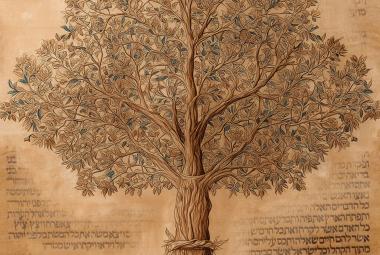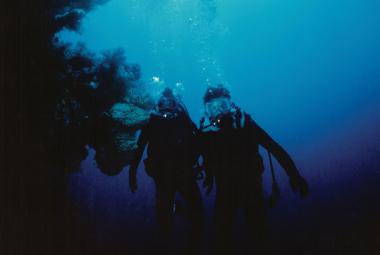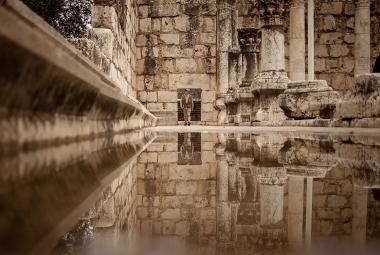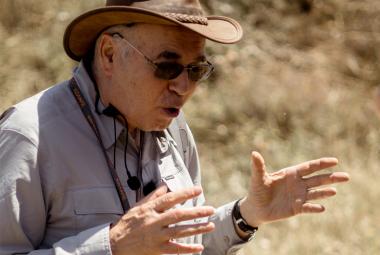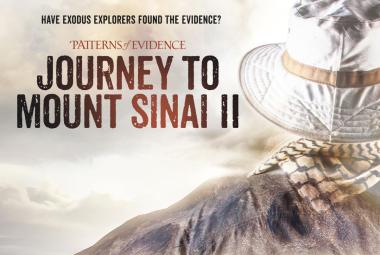On August 3, 1492, due to the Edict of Expulsion, all Jews were required to leave Spain. Boarding their vessels before midnight, and sailing one-half hour before sunrise, Columbus and his crew set out on their now-famous voyage1. His historic voyage was financed by wealthy and influential Jews - many themselves converts - rather than a magnanimous King and Queen of Spain. The source of Columbus' motivation was his Biblical view of scientific data as well as spiritual faith in the Scriptures.
A Second Homeland
Although their immigration into Europe technically started with the destruction of Jerusalem in A.D. 70 and the Diaspora it initiated, Jews had already begun to settle on the Iberian (Spanish-Portuguese) Peninsula centuries before Christ. From about the first century A.D. Spanish Jews, called Sephardim (from the Hebrew for the Iberian peninsula "Sepharad"), were making pilgrimage to Jerusalem. Paul even spoke of the need for missionary work among the Jews of Spain2.
After about A.D. 200, Spain became and remained a second Jewish homeland for well over a millennia. So deeply woven into the fabric of Spain are the Jews that neither history can be fully studied without considering the influence of the other.
Conversos and Marranos
The Jews in Spain became the target of pogroms and religious persecution. Many were forced to renounce Judaism and embrace Catholicism. These were known as Conversos, or converts.
Others, Marranos, feigned conversion, practicing Catholicism outwardly while remaining Jews inwardly. Marranos has two meanings in Spanish: "the damned" and "swine."
In response to a petition to Rome to introduce the Inquisition and find a final solution to their Jewish Problem, in 1487 Spain obtained a Papal Bull. The introduction of the Inquisition was motivated by the greed of King Ferdinand in his attempt to seize all the power and wealth in Spain. It was an instrument of avarice and political absolutism3. Four years later tens of thousands of Jews, Marranos, and even Conversos were suffering under the Spanish Inquisition.
The Role of Islam
In the 8th century, Muslim armies from North Africa invaded the Iberian Peninsula, fragmenting it into separate kingdoms known as the Spains. About 980 of these independent Spains began their Reconquista, War of Reconquest, against their Islamic invaders. The primary source of financing was trade with the Far East.
By the 1400s, the passages to the East were denied to the Christian West by the Muslims who controlled the main overland routes to the Orient. Bandits, desert heat and sand storms, as well as other hazards, eventually made Europe's alternate overland routes too dangerous and expensive. A new route, by sea, was the challenge.
By the late 13th century, the Christian kingdoms of Castile and Aragon had reconquered most of the Muslim-controlled territory. In 1479 the two kingdoms were united as a result of the marriage of Ferdinand II of Aragon and Isabella of Castile. The last Muslim kingdom, Granada, was reconquered in 1492, which seems to have set the stage for the famous voyage.
The Maritime Technology of 15th Century
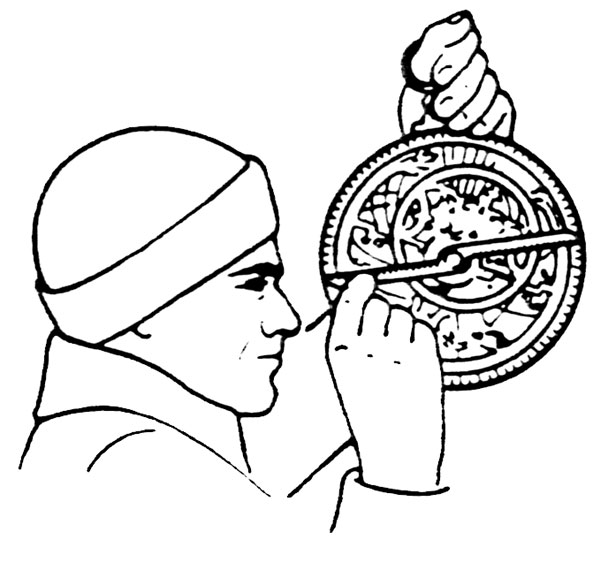 Contrary to popular belief, most of the educated class of 15th century Europe held to the concept of a spherical earth. Hebrew astronomers, like Abraham Zacuto, who the explorer Vasco Da Gama had consulted seeking a sea route to India around Africa, furnished the celestial time tables. Rabbi Levi ben Gershon, whose mathematical system became the basis for modern trigonometry, had invented a quadrant known as Jacob's Staff. This angle-measuring device was used by Columbus, Da Gama, and Ferdinand Magellan, the first to circumnavigate the earth. Abraham Ibn Esra, Jacob ben Machir, and Jacob Carsoni developed technical apparatus like the Astrolabe, used to determine the latitude and longitude of a position. Cartography, the art and science of making maps and charts, was also an area of Jewish expertise in Europe. One such specialist was Abraham Cresques, known as "The Master of Maps and Compasses." Another was his son, Jehudah ben Cresques, who administered several schools of cartography, thus preparing for the "age of discovery" on their horizon.
Contrary to popular belief, most of the educated class of 15th century Europe held to the concept of a spherical earth. Hebrew astronomers, like Abraham Zacuto, who the explorer Vasco Da Gama had consulted seeking a sea route to India around Africa, furnished the celestial time tables. Rabbi Levi ben Gershon, whose mathematical system became the basis for modern trigonometry, had invented a quadrant known as Jacob's Staff. This angle-measuring device was used by Columbus, Da Gama, and Ferdinand Magellan, the first to circumnavigate the earth. Abraham Ibn Esra, Jacob ben Machir, and Jacob Carsoni developed technical apparatus like the Astrolabe, used to determine the latitude and longitude of a position. Cartography, the art and science of making maps and charts, was also an area of Jewish expertise in Europe. One such specialist was Abraham Cresques, known as "The Master of Maps and Compasses." Another was his son, Jehudah ben Cresques, who administered several schools of cartography, thus preparing for the "age of discovery" on their horizon.
It was a young mariner and cartographer who was to combine these factors into a radical plan to reach the East by sailing west across the Ocean-Sea: Christopher Columbus.
Family Background
Italy asserts that Cristoforo Colombo was born in Liguria of humble means. They claim his father, Domenico Colombo, was a tower sentinel in Genoa and later a weaver in Savona4. Spain insists that Cristbal Coln was the son of Domingo Coln, a wool trader, and Susanna Fontanarossa, both of Pontevedra, Spain.
Other sources present the view that Columbus' family were Spaniards who lived in Italy but later returned to Spain, resuming their original family name of Coln.
Fifteenth century Portugal was Europe's dominant sea power, with Lisbon, its ocean-port capital, the center of navigational science and nautical speculation. Arriving in Lisbon in 1476, Columbus engaged in cartography, as well as working in his brother's book business. It was from the interchanges with scholars that Columbus crystallized his La Empresa de la Indies, his Enterprise of the Indies. He felt predestined, chosen for a mission. His name, Christ-Topher ("Christ-bearer"), he felt was evidence of his destiny.
Columbus was driven more by prophecy than astronomy. He compiled a collection of Biblical passages in his Libro de las Profecias, Book of Prophecies: Proverbs 8:27, which speaks of the earth's surface as being curved; Isaiah 40:22, the spherical earth; and the ocean currents in Isaiah 43:16.5 He would later describe his discovery of the New World as "the fulfillment of what Isaiah prophesied," from Isaiah 24:15, "...isles beyond the sea," and Isaiah 60:6.6
He also would have at least suspected the existence of the American continent. In his personal library was the 1472 edition of Bibliothecae Historicae, written by Diodorus Siculus, a first century B.C. Greek historian who spoke of "a very great island many day's sailing from Africa."
Many Portuguese cartographers were aware of the "Isle of Seven Cities," Antlia, located in the Western Atlantic. Also, a passage by Roger Bacon, "the sea between the western end of Spain and the eastern beginning of India is navigable in a very few days if the wind is favorable," was cited by Columbus in a letter to Ferdinand and Isabella in 1498 as one of the suggestions that had inspired his voyage in 1492.7
In 1483, Columbus' plan was rejected simply because they felt that the distance was too great. In 1487, Columbus left Portugal for Spain, and in 1489 he gained an audience with Queen Isabella and built his arguments on evangelistic aspects. She was so impressed theologically she submitted it to a special commission at the University of Salamanca, but in 1490 it was again rejected as the distance being too great.
However, the Queen assured Columbus that he could petition her again after the Reconquista was completed. When Granada, the last Muslim stronghold, fell in January of 1492, Columbus was summoned and the issue was reopened. When asked what he required to complete his plan, Columbus, to ensure the well-being of his now impoverished family, included 10% of all treasure and trade resulting. The extent of his requirements, along with the cost of the war, made it impossible for Spain to underwrite the expedition.
Soon after Columbus was dismissed, three men, Juan Cabrero, Luis de Santangel, and Gabriel Sanchez approached the monarchs. Aside from their being Conversos, these were not ordinary Spaniards. Santangel was a member of one of the wealthiest and most influential families in Spain, as well as the King's personal advisor. Juan Cabrero was Ferdinand's intimate friend who had fought by the King against the Muslims. Gabriel Sanchez was the Chief Treasurer of Spain. They offered to finance Columbus' project and it was accepted. Some scholars believe that Santangel and his associates were willing to finance Columbus in the hope of finding a new Promised Land to which they might emigrate and escape the pressure of the Church.8
The Inquisition
Tomas de Torquemada was appointed Inquisitor General in the autumn of 1483, providing the Inquisition with a new impetus. In less than 12 years, the Inquisition condemned no less than 13,000 Marranos, men and women who had continued to practice Judaism in secret.9 They were tortured in La Casas Santa, the Holy Houses, and burned alive at the stake while their property was divided between the Pope and the King.
When Granada fell on January 2, 1492, the drive toward complete religious unity was reinforced. On March 31, 1492, the Edit of Expulsion was signed. The deadline for Jews to leave Spain was August 3, 1492, which was, ironically, the Ninth of Av (Tisha B'av) on the Jewish calendar, a day of fasting commemorating the destruction of both Temples in Jerusalem.10 Columbus and his crew boarded their vessels before midnight, and on the August 3rd sailed before sunrise.
Was Columbus Jewish?
Columbus employed peculiar dates and phrases unique to the Hebrew people. Instead of referring to the "destruction" or "fall of Jerusalem," he used the phrase "the destruction of the second house." He also employed the Hebrew reckoning of A.D. 68 instead of A.D. 70. A marginal note dated 1481 is immediately given its Hebrew equivalent of 5241, etc. He boasted that he was related to King David, some of his letters were described as written in an "unknown script" (Hebrew?), and he is said to have used a unique triangular signature similar to inscriptions found on gravestones of ancient Jewish cemeteries in Spain and Southern France.
Was Columbus a Gentile or a Jew? Was he a Marrano or a Converso? Was he Cristoforo Colombo the Italian Catholic or Cristbal Coln the Spanish Jew? In the final analysis, Columbus' ethnic background is not the important issue, but rather - as is ultimately true for each of us also - his spiritual condition. The Word of God instructs us to "seek ye first the kingdom of God and His righteousness and all things will be added unto us."11
In this regard Columbus wrote: "No one should fear to undertake any task in the name of our Saviour, if it is just and if the intention is purely for His service." Just as a man's life does not consist in the abundance of the things he possesses, so Columbus' greatness does not come from his discovery of America, but because of his relationship with God through the Lord Jesus Christ. How are you doing in this regard? Where do you stand?
Notes:
- Encyclopaedia Britannica, Vol. 16, p. 670f.
- Romans 15:24, 28.
- See our briefing package The Kingdom of Blood.
- Columbus was no Genoese patriot: He fought on the Portuguese side in the battle of Cape St. Vincent, August 13, 1476 (Encyclopaedia Britannica, Vol. 16, p. 668).
- This passage, along with Psalm 77:19, also encouraged Matthew Fontaine Maury (1806-1873) to pursue mapping "the pathways in the sea" and thus become the Father of Oceanography.
- Encyclopaedia Britannica, Vol. 16, p. 688.
- Roger Bacon, Opus maius, iv, 4; copied in the Imago mundi (1480) by Cardinal Pierre d'Ailly, from Will Durant's The Story of Civilization, Vol. 4, p. 1010.
- A regathering prophesied in Jeremiah 23:3; 29:14; and 32:37.
- Encyclopaedia Judaica, Vol. 15, p. 242.
- See our briefing package The Feasts of Israel.
- Matthew 6:33.
Sources:
For a remarkable account from the translation of Columbus' logs, and other uplifting background on the founding of our nation, be sure to read The Light and the Glory, by Peter Marshall and David Manuel, Fleming H. Revell Co., Old Tappan, NJ, 1977. We are also deeply indebted to Tom Fontanes and his sources: M. Kayserling, Christopher Columbus and the Participation of the Jews in the Spanish and Portuguese Discoveries; Salvador de Madariaga, Christopher Columbus Being the Life of the Very Magnificent Lord - don Cristobal Colon; Gianni Granzotto, Christopher Columbus; Simon Wiesenthal, Sails of Hope: The Secret Mission of Christopher Columbus; and, Dr. Cecil Roth, Who Was Columbus?, as published in Countdown Magazine, 9/90.

